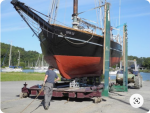Catalina36
N/A
My Catalina 36 has a 4 foot draught and a 3 ton wing keel. Its maiden voyage was from Massachusetts to Falmouth, then on to Holland. The delivery crew wrote a very complimentary report on its handling.Can a shallow keel boat cross an ocean, like the Atlantic?



